Easy Winter Watercolor Painting Ideas
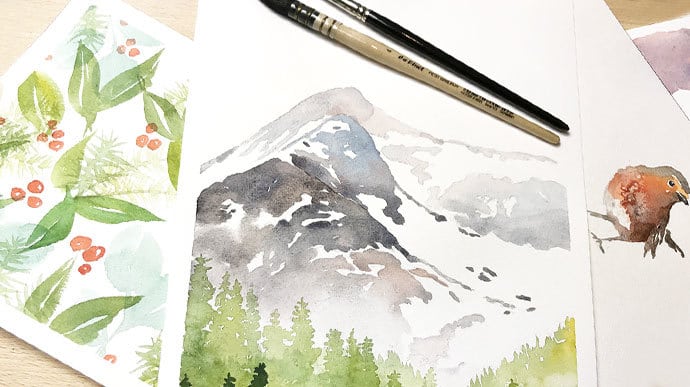
Brrr… it’s cold outside !
The coldest season of the year stirs up different emotions for all of us. There are lots of things that I associate with winter, all of which make great subjects for painting.
So in this tutorial I’m going to share a few winter watercolor painting ideas which you can also try yourself. You can download the worksheets for painting these ideas below.
Winter Watercolor Painting Ideas
If you’re looking for inspiration for things to paint during the cold season, just think of all the things that remind you of winter.
I’m going to show you how to paint three subjects in this tutorial – a winter mountain scene, some wintertime red robins, and a composition of winter leaves and berries.
For me, wintertime conjures up images of snowy mountain tops, and memories of time spent vacationing in the mountains, the arrival of red breasted robins, and the plants and trees that flourish at this time of the year offering some welcome color to the wintry season !
These are the ideas that I’ve chosen for following watercolor painting exercises…
Tips & Tricks
Tips & Tricks: Don’t feel daunted by what might sound like complicated subjects to paint. I’ve made the process simple and easy to follow.
The idea is to try to paint in a loose and free style. The objective isn’t realism, but more to enjoy the beautiful transparent characteristics of watercolor paints and the way colors blend together on the paper.
Winter Mountain Watercolor Scene
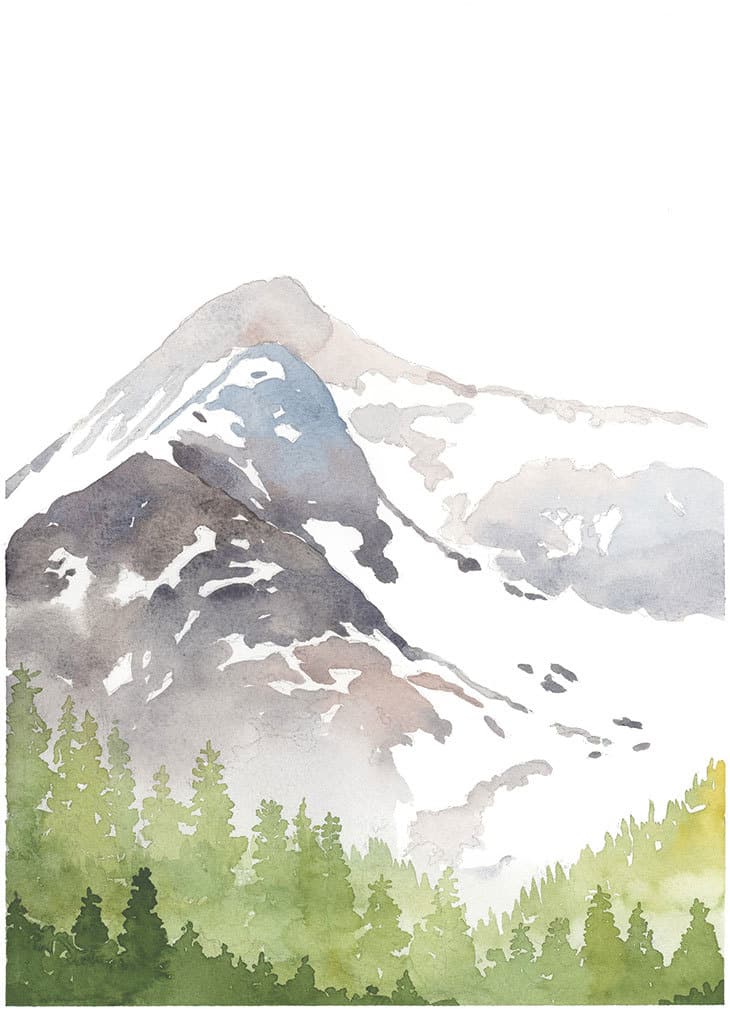
Try this painting for yourself ! You can download the worksheet for these compositions by clicking the button below.
The paint colors used in this painting were as follows (links go to Amazon):
- Hansa Yellow Deep – Pigment number: PY65
- Phthalo Green BS – Pigment number: PG7
- Prussian Blue – Pigment number: PB27
- Pyrrol scarlet – Pigment number: PR255
- Burnt umber – Pigment number: PBr7
- Payne’s gray – Pigment number: PB29 / PBk9
After sketching the outline of the mountain scene onto watercolor paper, fix the sheet down onto a flat board using masking tape.
Begin by painting the mountain range in the far background. To do this make sure you use a highly diluted mixture of paint. By making the far mountains light in color and the closest part of the mountains darker, this will help to add a sense of depth, as if the mountains were fading away into the background.
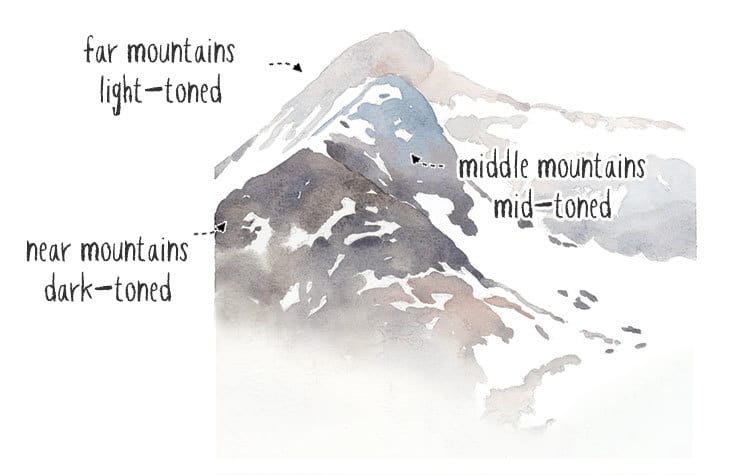
I’m using Payne’s gray as the basic color for the mountains, but to make the painting more interesting, I also added some Pyrrol scarlet, Burnt Umber, and Prussian blue to make warmer and cooler versions of gray.
Try to paint the backdrop of mountains in one go, and vary the color of your paint mixture while the surface of the paper is still damp. Painting with a wet-on-wet technique like this will produce a nice smooth blend of colors.
When the first layer of paint has dried continue with the middle distance mountains, using a slightly stronger mixture of gray. Leave the white paper untouched to represent the snow. Vary the color on your brush between cool, warm and neutral gray, and try to make the color darker, and stronger in value as you move downwards.
Leave the paint to dry again then begin painting the foreground mountains using darker valued paint. Once again, vary the color on your brush slightly as you work to produce a variegated wash
Tips & Tricks: A variegated wash is basically any shape which has a smooth transition of color. Adding different colors to the paper while the paint is still wet is a great way to achieve this.
This time, when you reach the bottom edge of the mountains, start to add clear water to your brush and blend the gray color so it becomes lighter towards the bottom of the sheet. The aim is to give an impression of mist or fog around the base of the mountains by making the color lighter
Tips & Tricks: This smooth progression from dark to light produces what’s known as a graduated wash.
Let the surface of the paper dry completely before starting to paint the trees in the foreground.
The trees will be painted in three stages in a similar way to the mountains, progressing in value from light to dark. The first layer of paint will be light, the second layer should be mid-toned, and the final layer will be dark.
Each layer needs to be left to dry before painting the next. Painting successive layers of watercolor like this is a technique known as glazing.
Prepare a fairly diluted mixture of green paint and start painting the distant row of trees. Do this in a similar way to how you painted the mountain, in other words, vary the color on your brush slightly to achieve a variegated wash, and paint the row or trees in one go while the paint is still damp.
Paint the trees as one big shape. Try not to think of them as individual trees or you’ll find yourself fussing over separate trees rather than painting the whole shape.
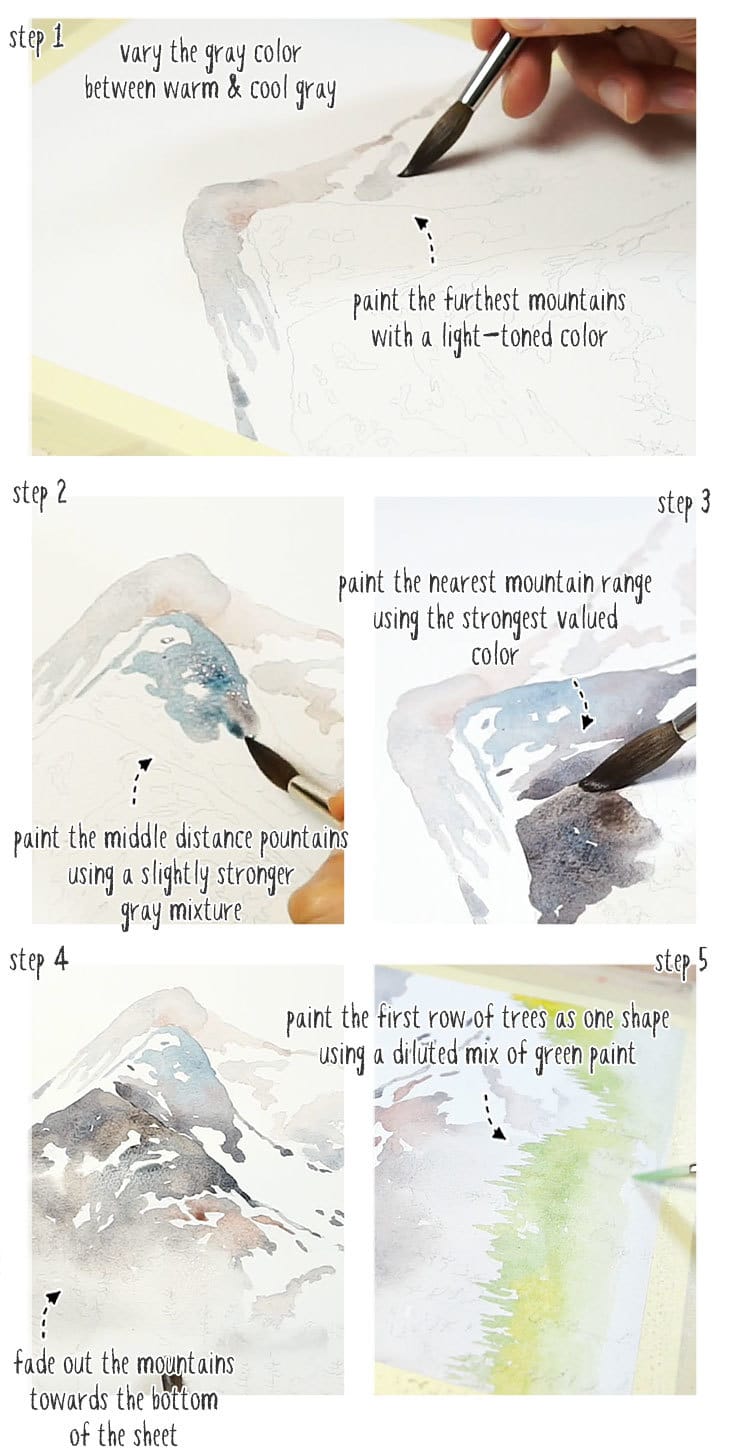
Let the first layer paint dry then begin painting the next row of trees using a slightly stronger valued green paint mixture.
Again, try not to think of these as individual trees. I’m using the tip of my brush to dab paint onto the paper to help create an outline to represent the crown of the trees.
You want to paint the whole shape as one continuous wash, with a bit of variation in color.
When you’ve finished, leave the paint to dry again and mix up some dark green paint for the trees in the foreground.
Use the same brush technique as before, dabbing color onto the paper until you’ve completed the shape of the nearest trees. Add some darker trees to both sides of the sheet to help balance the composition.
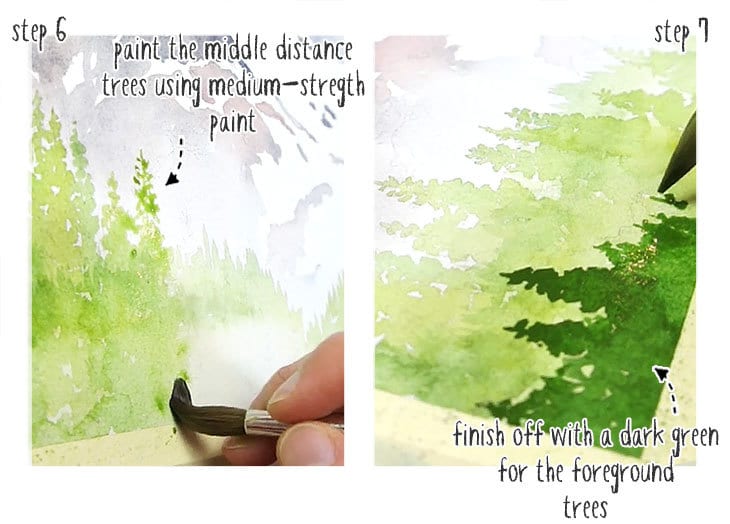
Wintertime Red Robins Paintings
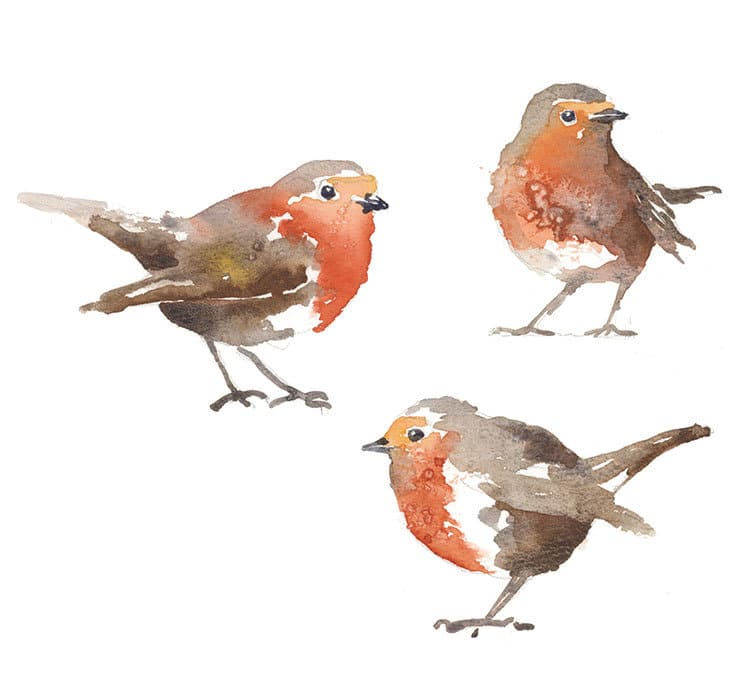
The paint colors used in this painting were as follows (links go to Amazon):
- Hansa Yellow Deep – Pigment number: PY65
- Pyrrol scarlet – Pigment number: PR255
- Burnt umber – Pigment number: PBr7
- Payne’s Gray – Pigment number: PB29 / PBk9
Now let’s have a look at how to paint the Red Robins.
Sketch the outline of the birds onto watercolor paper then fix the sheet onto a board so that it doesn’t move around while you work.
Remember the idea is to paint in a quick and loose style so that you don’t become absorbed with the details. To do this I painted the whole of the bird as if it were one continuous shape, moving quickly from one color to another.
Paint around the eye and the beak, and leave the white underbelly untouched, using the side of your brush to create a rough edge where the red breast feathers finish.
I used a mixture of Hansa yellow and Pyrrol scarlet for the orange color. And to add a textured effect, I dropped a few grains of salt onto the colored wash while the paint was still damp
Tips & Tricks: Salt absorbs moisture and will lift some of the wet paint off the surface leaving a lighter colored mottled texture.
While the surface is still wet, dab in some stronger paint to the underside and the edge, as a way to represent the shaded side of the bird, then start painting the rest of the bird shape with various browns and grays.
Add new brush strokes of color while the paint is still wet so that the colors blend and diffuse together nicely.
Paint the upper edge, and the left hand side with light toned paint, and add darker colors to the right hand side and underneath the bird. This helps give a sense of the direction of the light.
Paint the other birds using the same method. Vary the color and the tonal strength of the paint so that you get a variation in hue and value. Aim to paint the bottom and the right hand side of the bird shapes with darker colors as if the light were coming from the upper left.
Leave the paint to dry on all three birds then carefully remove the salt from the surface.
All that remains is to add a few details. Paint the eye’s and the beaks using a strong mix of Payne’s gray. Don’t forget to leave some white highlights for the eye and the beak.
As a final touch add some dark brown brush marks underneath and around the wings so that the wing shapes look separate from the body.
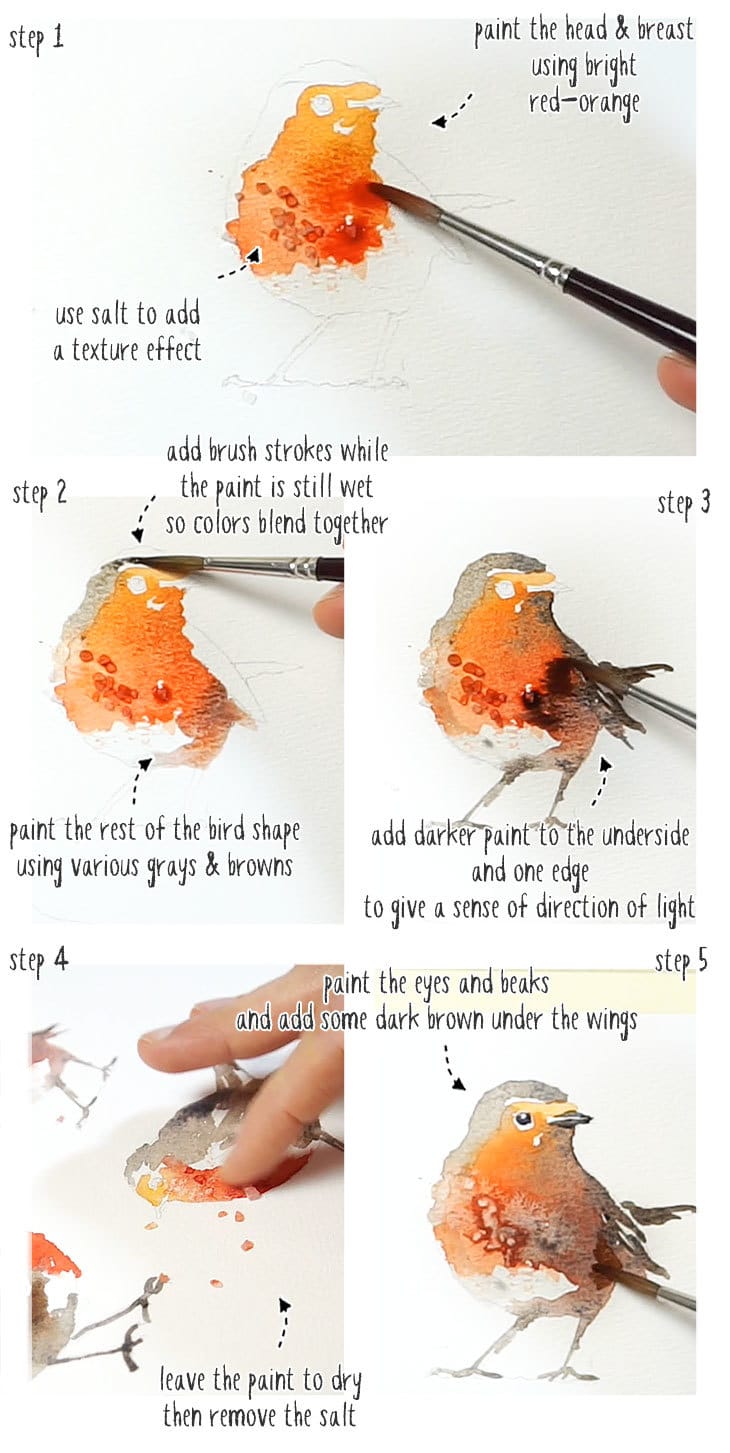
Winter Leaves & Berries Watercolor
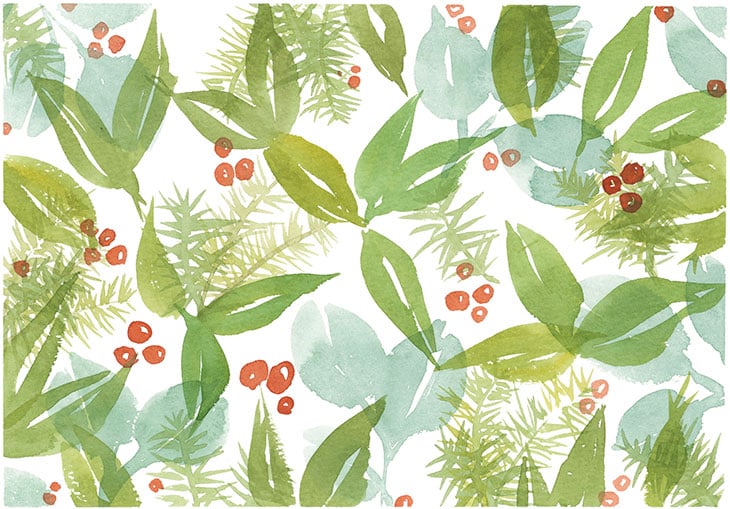
The paint colors used in this painting were as follows (links go to Amazon):
- Hansa Yellow Deep – Pigment number: PY65
- Phthalo Green BS – Pigment number: PG7
- Phthalo blue GS – Pigment number: PB15:3
- Pyrrol scarlet – Pigment number: PR255
Finally I’m going to show you how I painted the winter leaves and berries composition.
Tape down a sheet of watercolor paper onto a board, making sure the tape is firmly fixed down. When you remove the tape this will leave a nice white frame around the painting.
I didn’t draw any pencil guidelines for this watercolor, but if you feel more comfortable you can sketch some shapes onto the sheet before you begin.
I started by painting some big round leaves using a diluted mixture of blue-green paint. I painted these as groups of threes, because odd numbers like this tend to produce a more harmonious result. Notice also that I left a white gap through the middle of each leaf to represent the rib down the center.
Try to distribute the leaf shapes evenly across the sheet and paint as if the edges of the paper don’t exist so that the leaves overlap at the sides.
Let this layer of paint dry then start painting a new series of different leaf shapes. This time I used a mix of yellow-green paint and I’m painting small branches of pine leaves.
To do this I first painted a line for the stem, then I used an outward flicking motion with the brush to paint the individual pine needles.
Again, distribute these pine leaves evenly around the sheet and don’t hesitate to overlap the underlying leaf shapes. The aim is to build up layers of leaf shapes on top of each other so that the transparent paint lets the underlying pattern show through.
Tips & Tricks: Building up layers like this is called glazing in watercolor. For each layer of paint you let the paint dry completely before laying down new brush strokes.
You can even paint new darker pine leaves on top of the first layer of dried leaf shapes.
Leave the paint to dry again and prepare a mixture of stronger bright green paint for the next set of leaves.
This time I’m painting a series of longer pointed leaves. Again the idea is to paint over the existing leaf pattern and at the same time continue to fill in the blank white spaces on the paper.
Don’t forget to leave a white highlight down the center of each leaf.
Continue painting the same type of pointed leaf shapes. You can modify the color on your brush as you progress, for example by adding more yellow to the mixture as i did here.
When you’re happy with the distribution of leaf shapes across the surface, leave the paint to dry again and make a mixture of bright red in preparation for painting the berries.
Leave a small white highlight for each berry, and paint them in small groups or as individual berries.
The berries are the final touch to this composition. You can alter the strength of your red paint if you want to add some variation in tonal value. Red is a complimentary color compared to green. These two colors look good together because they produce a high level of color contrast.
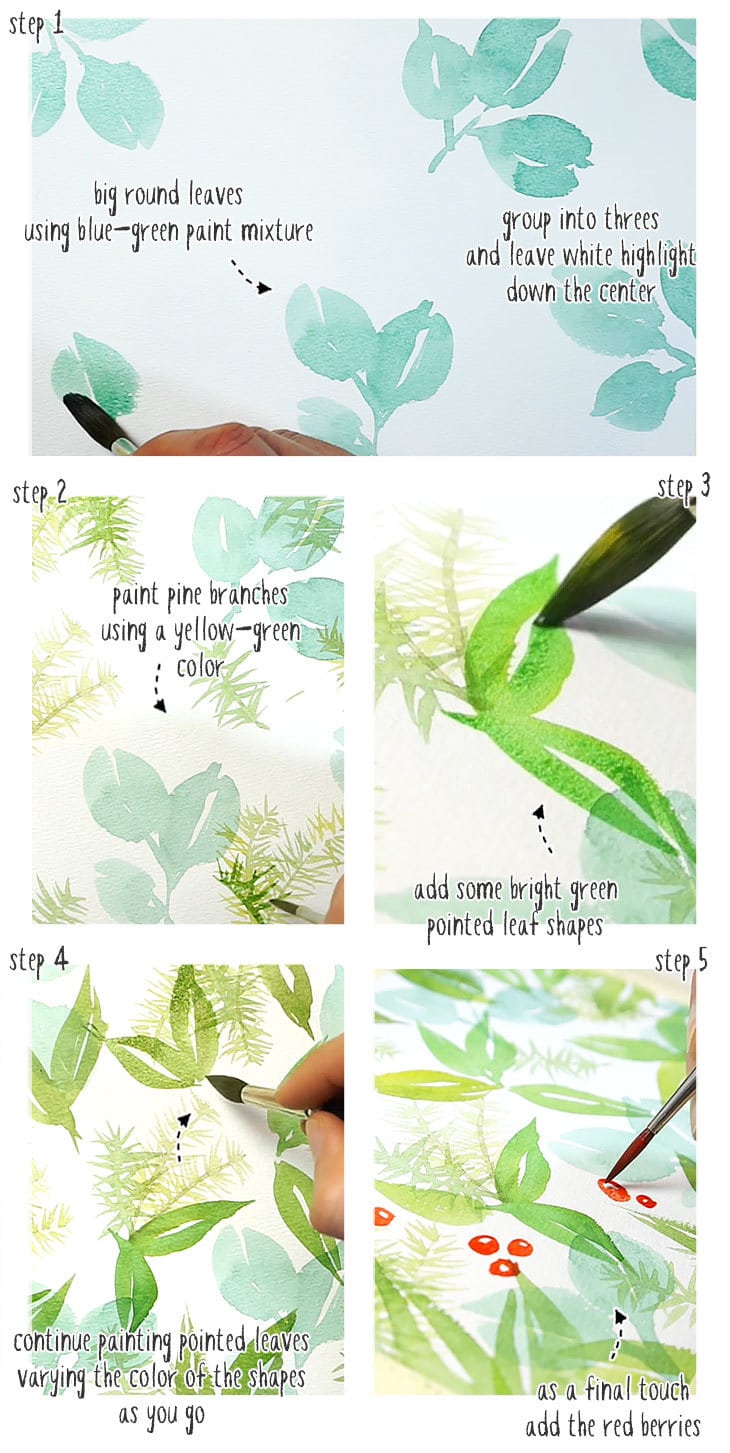
Winter Watercolor Inspiration
I hope you enjoyed these easy, winter inspired watercolor paintings. If you’re looking for inspiration while you’re warm and cosy during the winter months, pick any of your favorite wintery things and try to paint them in a quick, loose, and colorful composition, a bit like the paintings above !

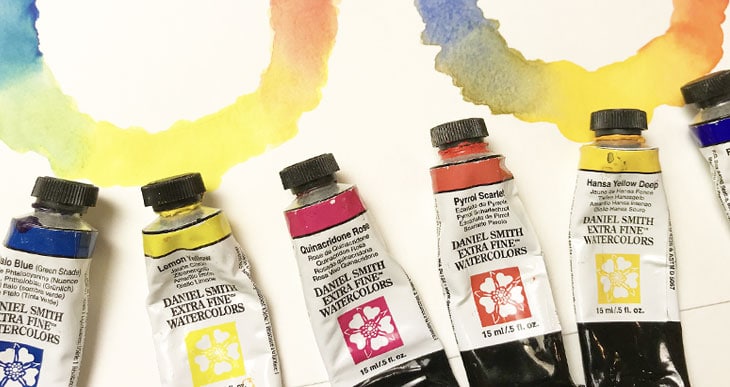
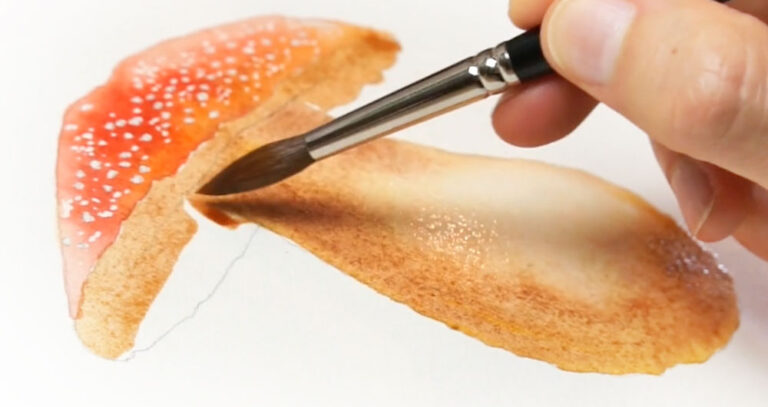
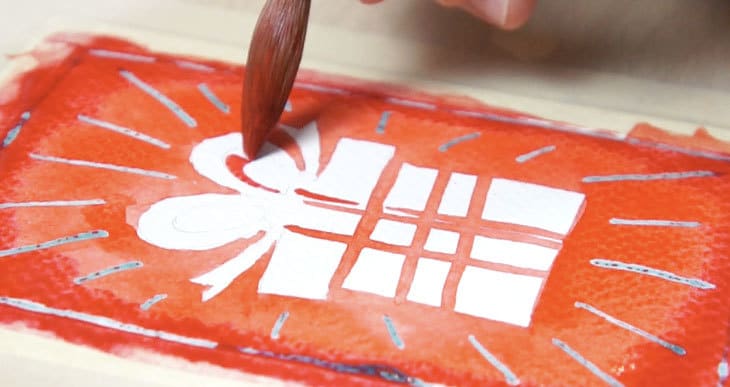
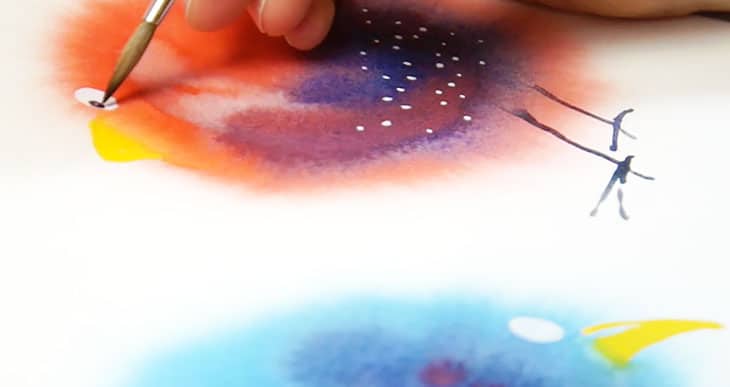
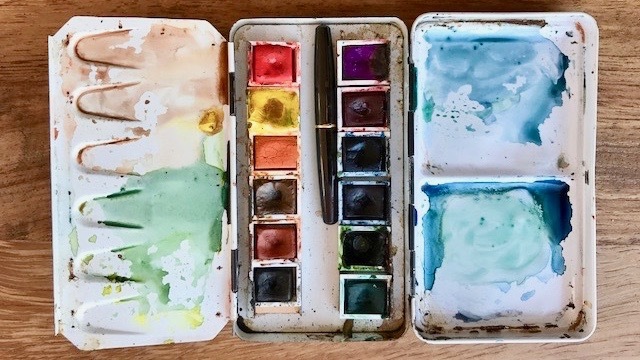
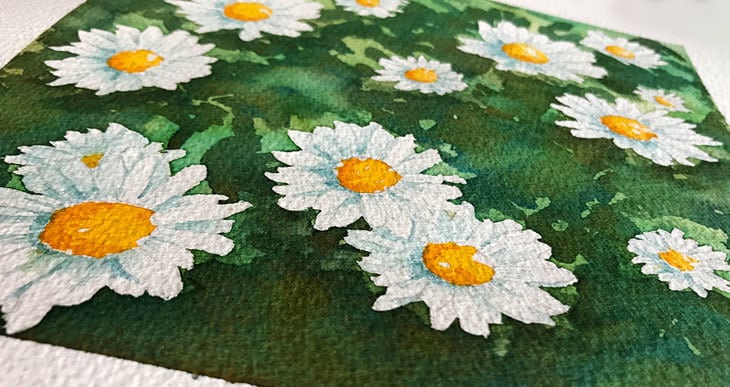
Thanks Anthony. You’re very generous in sharing these and other tutorials. I did the ones with oranges, and especially enjoyed the third one that had leaves and some layering/glazing. I still want to get out my colored pencils to see how I can add to it.
Have fun Anne 🙂
Thank you. I want to paint these on cards for a friend.
Hi Jo – Sounds great… Have fun !
Wonderful !!! I painted the mountain landscape , in the beginning I was so scared because It was the First time I paint a landscape but it work out beautifully !!! Thank you for the inspiration and happy new year!!! Feliz año from Chile .
Great news Alexa !
Happy new year to you to…
I painted the mountain scene and was very happy with the results! Thanks for the tutorial, it’ll be a birthday card for my friend. 🙂
Nothing beats a personalized watercolor card for birthdays 🙂
Thank you so much for sharing these with us. I’m getting ready to start them now. I’d love to take your classes but I just can’t afford it right now, but I look forward to your e-mails.
Hi Julianne
Glad you’re enjoying the lessons on my site… Have fun painting !
Thank you for these ideas. I’m going to try painting the robins.
Have fun Maggie !
Thank you, in the mountain scene are you using we on wet in each section of mountain and trees or just the first?
Hi Amy
Yes I’m using a wet-on-wet technique – Each shape is painted while the surface is damp so that different colors blend smoothly.